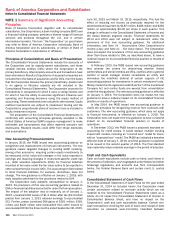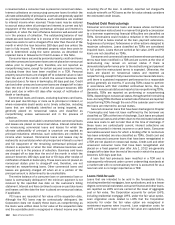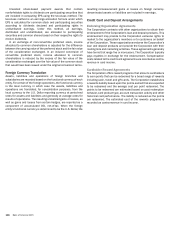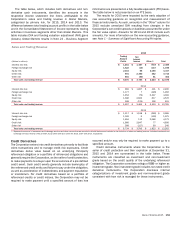Bank of America 2015 Annual Report Download - page 145
Download and view the complete annual report
Please find page 145 of the 2015 Bank of America annual report below. You can navigate through the pages in the report by either clicking on the pages listed below, or by using the keyword search tool below to find specific information within the annual report.Bank of America 2015 143
part of the carrying value of the loans and recognized as a reduction
of noninterest income upon the sale of such loans. LHFS that are
on nonaccrual status and are reported as nonperforming, as
defined in the policy herein, are reported separately from
nonperforming loans and leases.
Premises and Equipment
Premises and equipment are carried at cost less accumulated
depreciation and amortization. Depreciation and amortization are
recognized using the straight-line method over the estimated
useful lives of the assets. Estimated lives range up to 40 years
for buildings, up to 12 years for furniture and equipment, and the
shorter of lease term or estimated useful life for leasehold
improvements.
Internally-developed Software
The Corporation capitalizes the costs associated with certain
internally-developed software, and amortizes the costs over the
expected useful life. Direct project costs of internally-developed
software are capitalized when it is probable that the project will
be completed and the software will be used for its intended
function.
Mortgage Servicing Rights
The Corporation accounts for consumer MSRs, including
residential mortgage and home equity MSRs, at fair value with
changes in fair value recorded in mortgage banking income. To
reduce the volatility of earnings related to interest rate and market
value fluctuations, U.S. Treasury securities, mortgage-backed
securities and derivatives such as options and interest rate swaps
may be used to hedge certain market risks of the MSRs. Such
derivatives are not designated as qualifying accounting hedges.
These instruments are carried at fair value with changes in fair
value recognized in mortgage banking income. The Corporation
estimates the fair value of consumer MSRs using a valuation model
that calculates the present value of estimated future net servicing
income and, when available, quoted prices from independent
parties.
Goodwill and Intangible Assets
Goodwill is the purchase premium after adjusting for the fair value
of net assets acquired. Goodwill is not amortized but is reviewed
for potential impairment on an annual basis, or when events or
circumstances indicate a potential impairment, at the reporting
unit level. A reporting unit, as defined under applicable accounting
guidance, is a business segment or one level below a business
segment. The goodwill impairment analysis is a two-step test. The
first step of the goodwill impairment test involves comparing the
fair value of each reporting unit with its carrying value, including
goodwill, as measured by allocated equity. In certain
circumstances, the first step may be performed using a qualitative
assessment. If the fair value of the reporting unit exceeds its
carrying value, goodwill of the reporting unit is considered not
impaired; however, if the carrying value of the reporting unit
exceeds its fair value, the second step must be performed to
measure potential impairment.
The second step involves calculating an implied fair value of
goodwill for each reporting unit for which the first step indicated
possible impairment. The implied fair value of goodwill is
determined in the same manner as the amount of goodwill
recognized in a business combination, which is the excess of the
fair value of the reporting unit, as determined in the first step, over
the aggregate fair values of the assets, liabilities and identifiable
intangibles as if the reporting unit was being acquired in a business
combination. Measurement of the fair values of the assets and
liabilities of a reporting unit is consistent with the requirements
of the fair value measurements accounting guidance, as described
in Fair Value in this Note. The adjustments to measure the assets,
liabilities and intangibles at fair value are for the purpose of
measuring the implied fair value of goodwill and such adjustments
are not reflected on the Consolidated Balance Sheet. If the implied
fair value of goodwill exceeds the goodwill assigned to the reporting
unit, there is no impairment. If the goodwill assigned to a reporting
unit exceeds the implied fair value of goodwill, an impairment
charge is recorded for the excess. An impairment loss recognized
cannot exceed the amount of goodwill assigned to a reporting unit.
An impairment loss establishes a new basis in the goodwill and
subsequent reversals of goodwill impairment losses are not
permitted under applicable accounting guidance.
For intangible assets subject to amortization, an impairment
loss is recognized if the carrying value of the intangible asset is
not recoverable and exceeds fair value. The carrying value of the
intangible asset is considered not recoverable if it exceeds the
sum of the undiscounted cash flows expected to result from the
use of the asset. Intangible assets deemed to have indefinite
useful lives are not subject to amortization. An impairment loss
is recognized if the carrying value of the intangible asset with an
indefinite life exceeds its fair value.
Variable Interest Entities
A VIE is an entity that lacks equity investors or whose equity
investors do not have a controlling financial interest in the entity
through their equity investments. The entity that has a controlling
financial interest in a VIE is referred to as the primary beneficiary
and consolidates the VIE. The Corporation is deemed to have a
controlling financial interest and is the primary beneficiary of a VIE
if it has both the power to direct the activities of the VIE that most
significantly impact the VIE’s economic performance and an
obligation to absorb losses or the right to receive benefits that
could potentially be significant to the VIE. On a quarterly basis,
the Corporation reassesses whether it has a controlling financial
interest in and is the primary beneficiary of a VIE. The quarterly
reassessment process considers whether the Corporation has
acquired or divested the power to direct the activities of the VIE
through changes in governing documents or other circumstances.
The reassessment also considers whether the Corporation has
acquired or disposed of a financial interest that could be significant
to the VIE, or whether an interest in the VIE has become significant
or is no longer significant. The consolidation status of the VIEs
with which the Corporation is involved may change as a result of
such reassessments. Changes in consolidation status are applied
prospectively, with assets and liabilities of a newly consolidated
VIE initially recorded at fair value. A gain or loss may be recognized
upon deconsolidation of a VIE depending on the carrying values
of deconsolidated assets and liabilities compared to the fair value
of retained interests and ongoing contractual arrangements.
The Corporation primarily uses VIEs for its securitization
activities, in which the Corporation transfers whole loans or debt
securities into a trust or other vehicle such that the assets are
legally isolated from the creditors of the Corporation. Assets held
in a trust can only be used to settle obligations of the trust. The
























